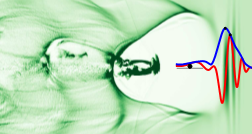Development of a kHz laser-plasma accelerator

In a laser-plasma accelerators, a very intense laser pulse is focused into a gas and creates a fully ionized plasma in a few femtoseconds. The laser pulse then drives a plasma wakefield which accelerates electron bunches with femtosecond duration. The electron beam is, in principle, perfectly synchronized with the laser (jitter-free) which is a great advantage for performing pump-probe experiments with unprecedented resolutions.
Developing a kHz laser-plasma accelerators relies on the use of a kHz laser. We use the Salle Noire laser at LOA which delivers 3 mJ pulse at kHz in only 3.5 fs, i.e. in a single light cycle ! These extreme pulse durations allow us to reach the laser intensity that is necessary to drive a large wakefield for accelerating electrons.
We have been developing this experiment for the past five years thanks to an ERC grant (FEMTOELEC). Our accelerator has currently reached a high level of reliability and delivers routinely electrons beams with few MeV electrons and charge in the 1-10 pC range.
Our current projects are focusing on:
- Physics: optimization of the injection process in the accelerator. Role of the absolute phase (CEP) in the injection and acceleration process
- Technology: developments of feed-back loops, control systems and differential pumping schemes for running our experiment like an accelerator
- Applications: (i) in condensed matter by performing time-resolved electron diffraction experiments, (ii) in radio-biology by doing femtosecond irradiation of biological cells…

Related publications:
“Identifying observable carrier-envelope phase effects in laser wakefield acceleration with near-single-cycle pulses”; J. Huijts, I. A. Andriyash, L. Rovige, A. Vernier and J. Faure, Phys. Plasmas 28, 043101 (2021)
“Demonstration of stable long-term operation of a kilohertz laser-plasma accelerator”; L. Rovige, J. Huijts, I. Andriyash, A. Vernier, V. Tomkus, V. Girdauskas, G. Raciukaitis, J. Dudutis, V. Stankevic, P. Gecys, M. Ouillé, Z. Cheng, R. Lopez-Martens, and J. Faure, Phys. Rev. Acc. & Beams 23, 093401 (2020)
“A review of recent progress on laser-plasma acceleration at kHz repetition rate” ; J. Faure, D. Gustas, D. Guénot, A. Vernier, F. Böhle, M. Ouillé, S. Haessler, R. Lopez-Martens and A. Lifchitz, Plasma Physics Controlled Fusion 61, 014012 (2019)
“High-charge relativistic electron bunches from a kHz laser-plasma accelerator”; D. Gustas, D. Guénot, A. Vernier, S. Dutt, F. Böhle, R. Lopez Martens, A. Lifschitz and J. Faure, Phys. Rev. Acc. & Beams 21, 013401 (2018)
“Relativistic electron beams driven by kHz single-cycle light pulses”; D. Guénot, D. Gustas, A. Vernier, B. Beaurepaire, F. Böhle, M. Bocoum, M. Lozano, A. Jullien, R. Lopez-Martens, A. Lifschitz and J. Faure, Nature Photonics 11, 293 (2017)
Contact: Jérôme Faure
People involved: Jérôme Faure, Aline Vernier, Catherine Leblanc, Igor Andryash, Lucas Rovige, Julius Huijts, Joséphine Monzac


